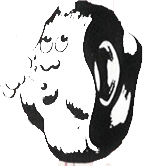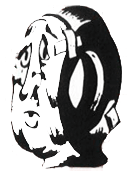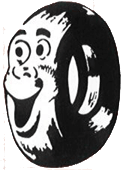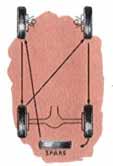| TIRES |

OVER INFLATION
HARD RIDE
POOR TRACTION
FABRIC BREAKS

UNDER INFLATION
RUNS HOT
LOOSENS CORDS
BLOWOUTS
UNEVEN WEAR

PROPER INFLATION
GOOD RIDE
GOOD TRACTION
EVEN WEAR
MORE MILEAGE
Your Buick is equipped with tubeless tires on disc wheels; however, a tube and tire combination is used with optional wire wheels. Tubeless tires resist blow-out from impact breaks and give a slow loss of air instead of a blow-out. Puncture sealant is not specified in these tubeless tires; however, air loss due to a puncture is much slower from a tubeless tire and a nail can usually be left in until a service station can be reached. Tires should be inspected periodically, preferably each time the care receives Lubricare, and puncturing objects removed. When puncturing objects are removed, repairs will have to be made according to recommendations of the tire manufacturer.
For maximum tire service - keep tires properly inflated - user an accurate gauge - after inflating, be sure valve caps are in place and screwed down fingertight.
|
EXTRA LOW PRESSURE TIRES |
Use air pressure as indicated below for checking proper inflation.
24 Lbs. (starting pressure) AFTER the car has been standing for three hours or driven less than a mile.
26 Lbs. (city pressure) AFTER driving the car three miles or more BELOW 40 miles per hour.
28 Lbs. (highway pressure) AFTER driving the
car three miles or more ABOVE 40 miles per hour.
It is normal for air pressure to build up in a tire due to driving conditions.
DO NOT LET AIR OUT OF TIRES TO REDUCE THIS INCREASE IN PRESSURE
 |
EQUALIZE WEAR ON TIRES CHANGE TIRES TO POSITIONS SHOWN IN DIAGRAM AT LEFT AT LEAST EVERY 4000 MILES. This change of position helps out uneven wear on front tires and distributes the faster wear on the rear tires over all five tires. |
|
CLEANING WHITE SIDEWALLS |
| Use soap, warm water, and stiff
brush to remove road grime and curb dirt from white sidewall tires.
Use medium or fine steel wool for sever cases. Do not use gasoline, kerosene, or any oil product that will discolor the sidewalls and rot the rubber By comparing air pressure in all tires, any variation in pressures will be evident. To prevent flat tires, investigate and correct a continued loss of air in any tire. |